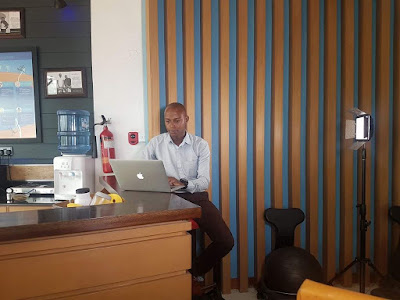 The noise about the next big thing can make it difficult to
identify which technologies truly matter. I will attempt to sort through the
many claims to identify the technologies that have the greatest potential to
drive substantial economic impact and disruption before or by 2030(our
country’s vision set plan). Important technologies can come in any field or
emerge from any scientific discipline, but initiative by his ministry and hope to see
such moves in several other ministries and NGOs as well.Therefore, as a country,we
need to focus on technologies that we believe will have significant potential
to drive economic impact and disruption by 2030.
The noise about the next big thing can make it difficult to
identify which technologies truly matter. I will attempt to sort through the
many claims to identify the technologies that have the greatest potential to
drive substantial economic impact and disruption before or by 2030(our
country’s vision set plan). Important technologies can come in any field or
emerge from any scientific discipline, but initiative by his ministry and hope to see
such moves in several other ministries and NGOs as well.Therefore, as a country,we
need to focus on technologies that we believe will have significant potential
to drive economic impact and disruption by 2030.
What Safaricom has done in enhancing mobile Internet, for
example, has affected more than 16 million Kenyans going about their lives,
giving them tools to become potential innovators or entrepreneurs— making the
mobile Internet one our most impactful technologies. I personally an a
beneficiary of their noble initiative to nature and grow talent within STEM.My
focus for now is profoundly learn the Internet of Things technology which will
connect and embed intelligence in billions of objects and devices all
around the world not Kenya alone, affecting the health, safety, and
productivity of billions of people.I want to be part of the few folks who
will go down the history books of STEM in Africa that shaped the path of the
four disciplines and made life of the coming generation better from our
engineered solutions.
Here is what I sorted out as the buzz in-things for Tech
evangelist, engineering gurus and STEM lovers which will definitely shape our
country in the next few years and propel the big 4 agenda to realization.
1. Mobile Internet Increasingly inexpensive and capable
mobile computing devices and Internet connectivity
2. Automation of knowledge work intelligent software systems
that can perform knowledge work tasks involving unstructured commands and
subtle judgments
3. The Internet of Things Networks of low-cost sensors and
actuators for data collection, monitoring, decision making, and process optimization
4. Cloud technology Use of computer hardware and software
resources delivered over a network or the Internet, often as a service
5. Advanced robotics increasingly capable robots with
enhanced senses, dexterity, and intelligence used to automate tasks or augment
humans
6. Autonomous and near-autonomous vehicles Vehicles that can
navigate and operate with reduced or no human intervention
7. Next-generation genomics Fast, low-cost gene sequencing,
advanced big data analytics, and synthetic biology (“writing” DNA)
8. Energy storage Devices or systems that store energy for
later use, including batteries
9.3D printing Additive manufacturing techniques to create
objects by printing layers of material based on digital models
10. Advanced materials Materials designed to have superior
characteristics (e.g., strength, weight, conductivity) or functionality
11. Advanced oil and gas exploration and recovery
Exploration and recovery techniques that make extraction of unconventional oil
and gas economical
12. Renewable energy Generation of electricity from
renewable sources with reduced harmful climate impact
The technologies on my list have great potential to improve
the lives of billions of people, starting with our 45 million plus
population. Cloud computing and the mobile Internet, for example, could raise
productivity and quality in education, health care, and public services. At the
same time, some of these technologies could bring unwanted side effects. The
benefits of the mobile Internet and cloud computing are accompanied by rising
risks of security and privacy breaches. Our 12th parliament ought to
sit more frequently and speed up the data protection bill, the computer misuse
and cybercrime bill and improve our information and communication act. Objects
and machines under the control of computers across the Web (the Internet of
Things) can also be hacked, exposing factories, refineries, supply chains, power
plants, and transportation networks to new risks
In considering the disruptive potential of these
technologies, I foresee that each could drive profound changes across many
dimensions—in the lives of Kenyan citizens, in business, and across the global
economy. As noted from key speeches from our president Mr.Kenyatta and his
deputy Mr.Ruto, the future seems bright for entrepreneurs and innovators. 3D
printing, the mobile Internet, cloud technology, and even next-generation
genomics could provide the opportunities and the tools to allow small
enterprises to compete on a meaningful scale and advance into new markets
rapidly.Almost every technology on my list could change the game for
businesses, creating entirely new products and services, as well as shifting
pools of value between producers or from producers to consumers. Some, like
automation of knowledge work and the mobile Internet, could also change how
companies and other organizations structure themselves, bringing new meaning to
the anytime/ anywhere work style. With automation of knowledge work tasks,
organizations that can augment the powers of skilled workers stand to do well.
As these disruptive technologies continue to evolve and play
out, it will be up to business leaders, entrepreneurs, policy makers, and
citizens to maximize their opportunities while dealing with the challenges.Lets
make our mother country great and change the face of Africa!
Compiled & Authored by: Samwel Kariuki


